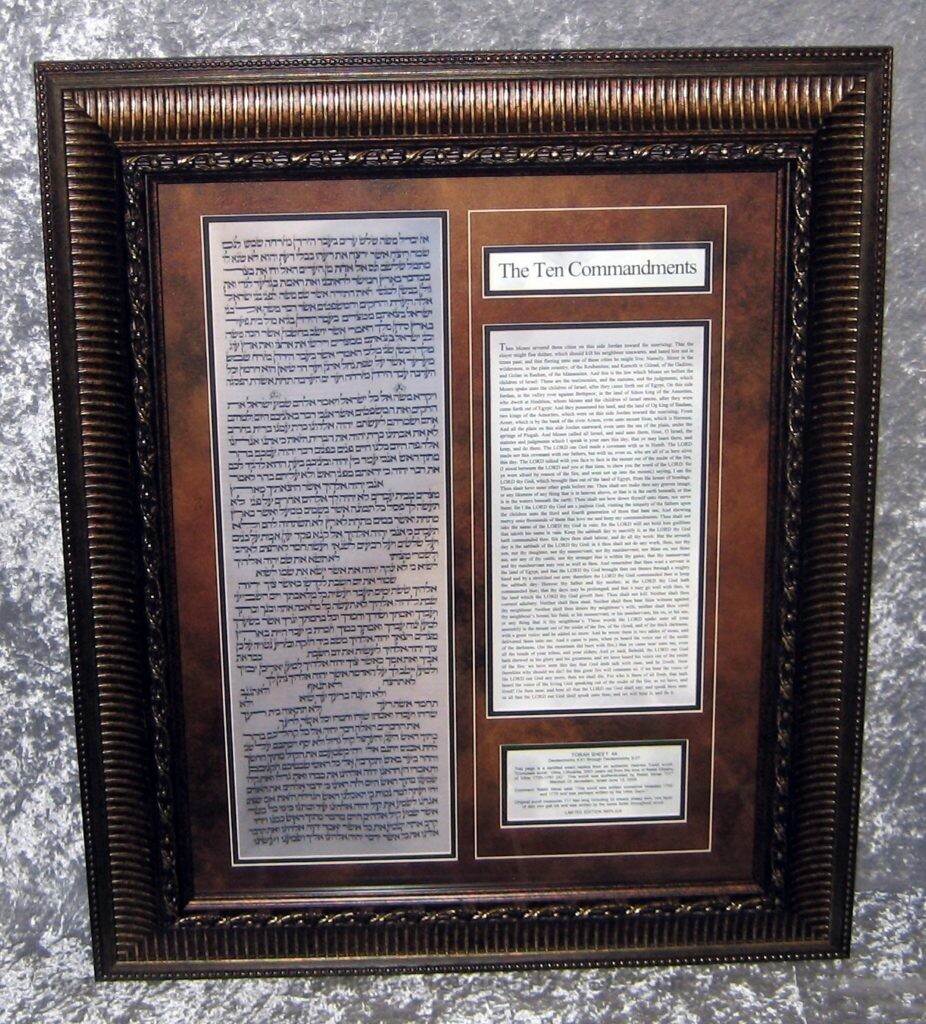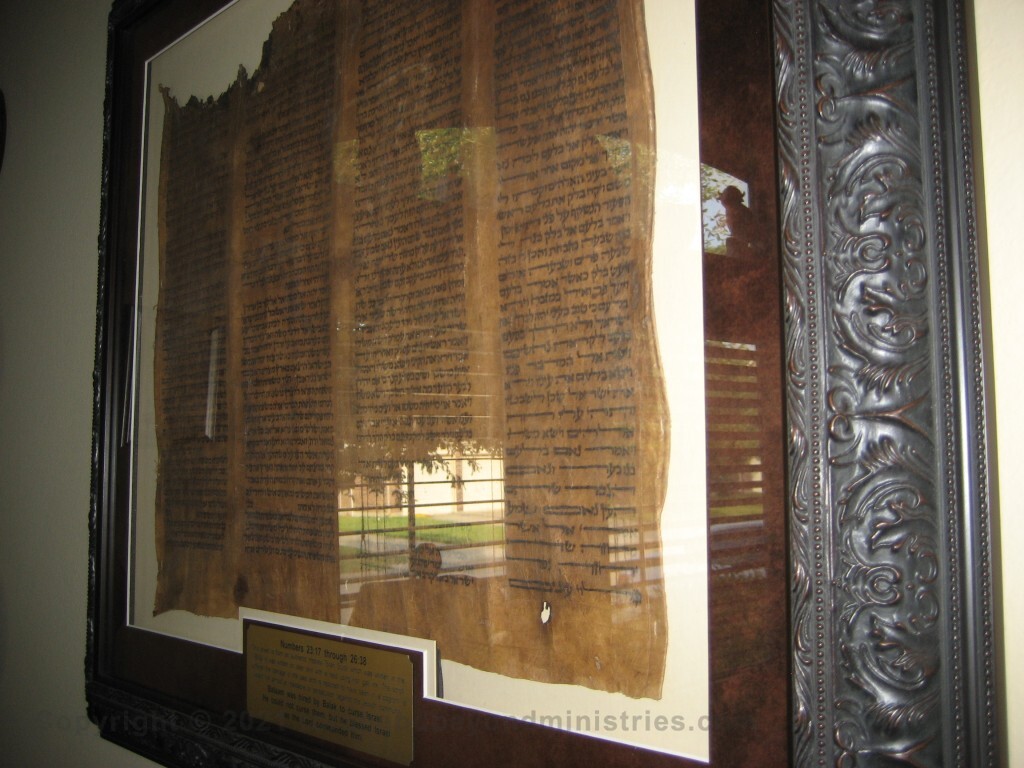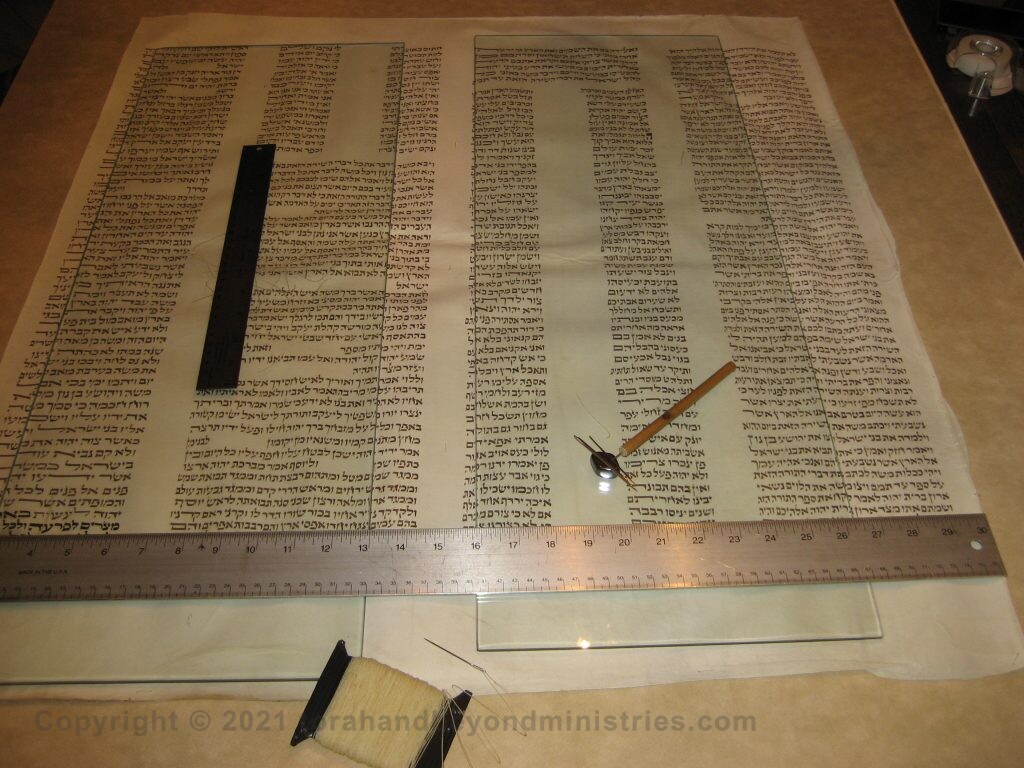Preservation of Biblical Hebrew Scrolls
When a Scroll or part of a Scroll can never be made kosher again I frame the sheets to preserve them. Otherwise the sheets would be put in a geniza and would never be seen again.
Contact:
gracetranscendingthetorah.com@gmail.com
All frames are made with the highest standard: wooden, acid free mating, UV Protected glass. In the newer shadowbox style, the Scripture is sewn to a mat using kosher giddin (sinew).
The dating on each manuscript is determined in the following way. By the information of the seller to me, amount and type of iron gall ink degradation, manner of stitching, condition of each piece showing damage by usage or on purpose as in the Holocaust or Pogrom, re-inking on letters to make them kosher again, the number of times a re-inking has occurred. Many sellers arbitrarily add a date to a Scroll. Whenever possible I have used the advice and dating of professionals; e.g., Soferim, Rabbis, seminaries, Hebrew scholars. I have worked with Hebrew Scrolls for over 20 years and have personally located and purchased almost 100 Scrolls and or parts of Scrolls. I have located and purchased two complete sets of Scrolls that make up the 16 Scrolls of the Tanakh (Old Testament). When a Scroll or part of a Scroll can never be made kosher again I frame the sheets to preserve them. Otherwise the sheets would be put in a geniza and would never be seen again.
Note:
The framed sheets can not be shipped. If you are in the East Texas area you can pick up the frame. At the end of the framed sheet section I have included many portions from various Scrolls that I did not frame. I did sew them to acid free backings to make it convenient for you to frame them. Kosher giddin (sinew) was used for the sewing.
Suggestions for framing large sheets of parchment.
Complete Scroll of Lamentations damaged in the Holocaust
The next sheet is from a Sephardi Torah Scroll which is perhaps 200 years old. It was written on deer skin with a reed using iron gall ink. The scroll suffered fire damage in the past and is reported to have been in a pogrom against the Jewish community.
The Scripture contained in this sheet starts in the book of Numbers chapter 23:17 and ends in chapter 26:38. This is the prophecy of Balaam when he was hired by Balak to curse Israel. He could not curse Israel but he blessed them as was commanded by the Lord.

2. Manuscript sewn to matting with kosher sinew

Framing Hebrew Manuscripts
All of these photographs can be greatly enlarged by right clicking.
It is the desire of this website that all the photographs (with the exception of the ones marked) and lessons be used for the glory of the God of Abraham, Isaac, and Jacob for educational purposes, therefore we encourage you to copy and use them free of charge and distributed, but not to be sold.
All the photos are licensed as follows: may freely be used under the Creative Commons copyright – Licensees may copy, distribute, display and perform the work and make derivative works and remixes based on it only if they give the author or licensor the credits by including a link to this website https://www.gracetranscendingthetorah.com Licensees may distribute derivative works only under a license identical (“not more restrictive”) to the license that governs the original work. Licensees may copy, distribute, display, and perform the work and make derivative works and remixes based on it only for non-commercial purposes. Contact information: gracetranscendingthetorah.com@gmail.com
“They Shall Mount Up With Wings As Eagles”




Deerskin Torah Sheet
Genesis 11:27 through Genesis 16:11
This sheet is from an old, very fragile, Hebrew Torah Scroll which was written with a reed using iron gall ink on deerskin in Iraq before 1900. It contains the call of Abram and the blessings bestowed upon him by God.
“In thee shall all families of the Earth be blessed”

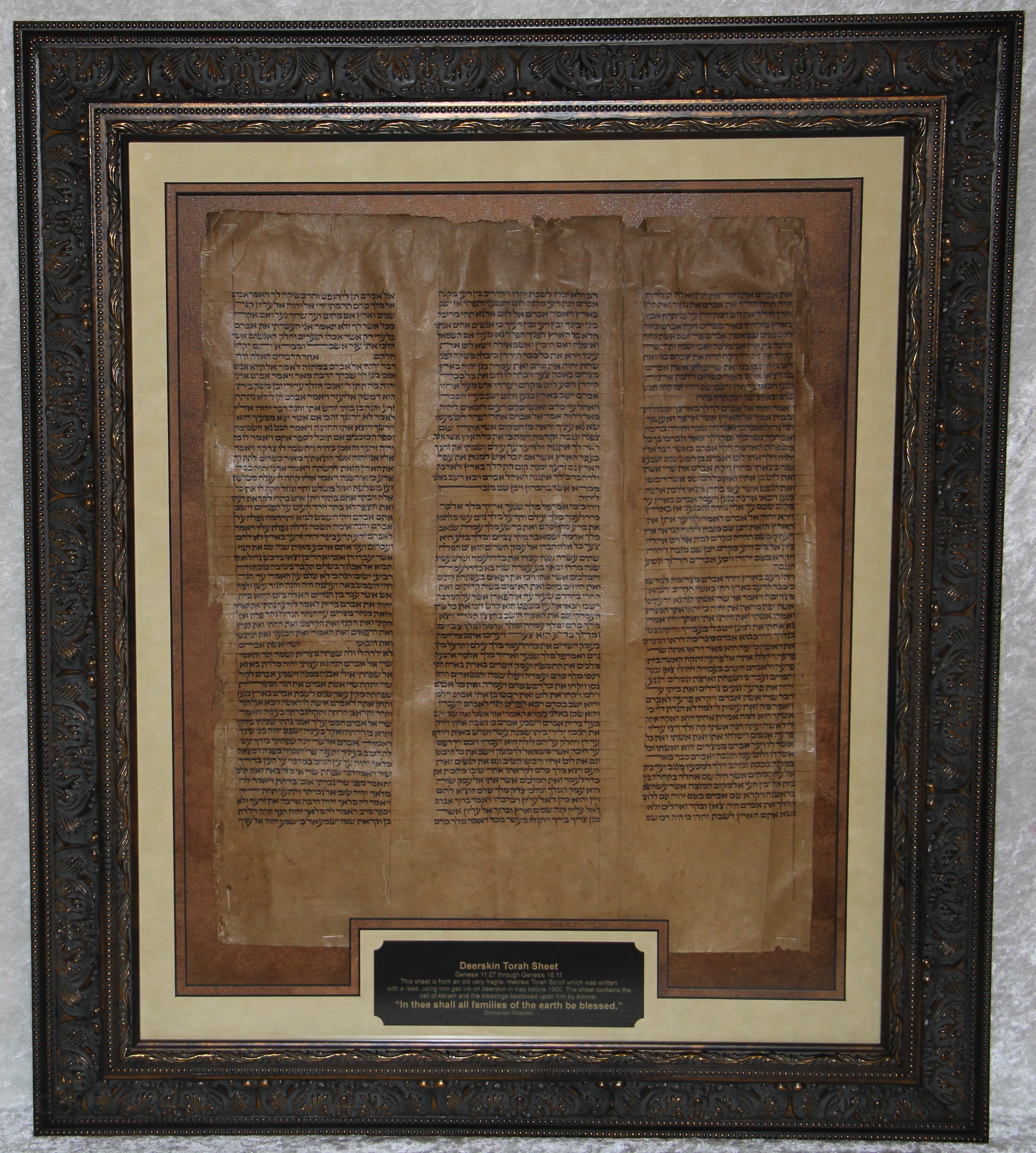
Torah Sheet Column Deuteronomy 10:4 through Deuteronomy 11:23
This sheet is from a very old Torah Scroll which was written with a quill, using iron gall ink, on sheepskin in Poland before 1800, probably much earlier. The column mentions the second set of the Tables of Stone and the blessings of Adonai.
“For the Lord is God of gods, and Lord of lords, a Great God”


“And he believed in the LORD; and he counted it to him for righteousness.”
I just finished framing a sheet from an old damaged Torah Scroll written in the 1800s in Romania. I purchased this Scroll in Jerusalem in 2005, and because it could never be made kosher again we distributed pages from the Scroll around the world. I kept this sheet because it has two passages that really touched my heart.
This sheet contains Scripture from Genesis 13:10 through 17:2
Two prominent New Covenant Scripture quotations are both taken from the Word of God written in the middle column of this sheet.
The following verse is taken from the middle of the second line from the top. Genesis 14:18 “And Melchizedek king of Salem brought forth bread and wine: and he was the priest of the most high God.”
The New Covenant quote is found in Hebrews 7: 1 For this Mechizedek, king of Salem, priest of the most high God, who met Abraham returning from the slaughter of the kings, and blessed him; 2 To whom also Abraham gave a tenth part of all; first being by interpretation King of righteousness, and after that also King of Salem, which is, King of peace;
The following verse it taken from Genesis 15:6 which starts in the middle of the second line from the bottom. “And he believed in the LORD; and he counted it to him for righteousness.”
The New Covenant quote is found in Romans 4: 3 For what saith the scripture? Abraham believed God, and it was counted unto him for righteousness.


Numbers 34
The Promised Land
I had an old damaged Torah Scroll that could no longer be repaired to make it kosher again* so we donated pieces of it around the world to people, institutions, churches, seminaries and even many pages back to Israel. I saved just a few pieces of this Scroll that have meant a lot to me, one of which I just sewed to an acid free mat with kosher sinew. This column contains the exact boundaries for the land promised to Abram and His descendants through Isaac and Jacob.
The yad (hand) is pointing to the start of the verses where the boundary stakes are driven.
The surveyor’s plat – The Word of God in Numbers 34:1-15 shows the South, North, West, East markers. This is The Land Promised by God first to Abram 3,930 years ago then reaffirmed to the Nation of Israel 3,426 years ago.
Read it in Hebrew or any other language. This has not been hidden from the world to read. Believe it or not.

CREATION
The Creation account photograph of a deerskin Torah Scroll written in Iraq. In my opinion, I believe this well used and damaged was written before the 20th century. There are several letters that show iron gall ink degradation and many have been re-lettered.
I just sewed this Torah sheet to an acid free mat with kosher sinew and will prepare to frame it this week.
The Scroll starts at Genesis 1:1 and ends in Genesis 5:11
Just a few of the highlights in this section.
-
- The Creation
- Time is set with an evening and a morning
- Earth was made before the stars.
Genesis 1:14-19 And God said, Let there be lights in the firmament of the heaven to divide the day from the night; and let them be for signs, and for seasons, and for days, and years: And let them be for lights in the firmament of the heaven to give light upon the earth: and it was so. And God made two great lights; the greater light to rule the day, and the lesser light to rule the night: he made the stars also. And God set them in the firmament of the heaven to give light upon the earth, And to rule over the day and over the night, and to divide the light from the darkness: and God saw that it was And the evening and the morning were the fourth day. - The fall of mankind
- The promise of a redeemer
- The first family had MAJOR problems
- When the iron age and bronze age really started is cleared up. They started right outside of the Garden of Eden with Tubalcain 4:22

The Creation account photograph of a deerskin Torah Scroll written in Iraq.
The Creation
This very old Torah Scroll has been re-lettered.
When you right mouse click twice on this image you can clearly see the re-lettering. Notice the third Hebrew word from the right on the second line, the pey is a good example of re-lettering.

Genesis 1:1 to Genesis 5:9
The Creation account, The Garden of Eden, The temptation by the Serpent, The Fall of mankind, The promised Messiah, Cain and Able, “Eve was the mother of all living” The Brass and iron age explained, The longevity of mankind before the Flood

Shir HaShirim The Song of Solomon
I just finished sewing my last Scroll of Shir HaShirim to an acid free mat and will frame it in the next few weeks. This Scroll is probably from Lithuania or Poland. It is more common to find very large Scrolls from these two countries. This is a very large Scroll measuring 30 inches wide and 20 inches tall. There is no doubt that this Scroll went through the Holocaust and suffered mishandling. It is a very old Scroll and shows much iron gall ink degradation.
The only way to save this Scroll is to frame it.
You may enlarge this high resolution photograph by right mouse clicking it

The Day of Atonement
This photograph is from a very old deerskin Torah Scroll.
The Hebrew text is as follows:
Leviticus 15:19 through Leviticus 17:10
Column 1 first column on the right 15:19 through 16:7
Column 2 second from right 16:8 through 16:25
Column 3 left column 16:25 through 17:10
This old well used and well-worn Torah scroll can never be made kosher again. It has quite a bit of iron gall ink degradation, re-lettering, corrections, and is very fragile. The Scroll was written on deerskin with a reed using iron gall ink. Because of the condition of the lettering, I estimate this Scroll was written in the 1800s or perhaps earlier. The only way to preserve this treasure was to frame it, otherwise it was bound for the geniza never to be seen again. I just finished sewing this sheet to an acid free mat. To properly sew the skin to the mat twelve feet of Kosher giddin was used. The sheet was then professionally framed with the shadow box effect using a wood black and gold frame. The glass is high quality UV protection. I had no idea how delicate this old Torah was until I started working with it.


Leviticus 23 The Feasts of the Lord
Photograph of a very old deerskin Torah Scroll. The section starts at the bottom of the second column on the right and ending at the completion of the first paragraph at the top of the fifth column from the right. This truly is a magnificent Scroll.
This old well used and well worn Torah scroll can never be made kosher again. It has quite a bit of iron gall ink degradation, re-lettering, corrections, and is very fragile. The only way to preserve this treasure is to frame it.

The back of the Leviticus 23 Scroll. This Scroll has been well used for at least a century, perhaps two or three centuries. Indications of it’s age are first the iron gall ink degradation on the letters, second, the manner of stitching the sheets together, and third, the amount of patching and coloration of the patches. It was patched throughout a great length of time.

Creation and the Fall of Mankind
This sheet is from an authentic Sephardic Hebrew Torah scroll originally produced in Morocco, North Africa. The Torah has been dated to have been written near the beginning of the French “Protectorate” of Morocco around 1915. Each sheet is written on goat skin which is a poor writing medium, many times requiring the sheets to be painted with Log, a white chalky substance. After about a hundred years of use, the log starts to flake which damages the letters rendering the scroll pasul, not kosher. All three layers of the goat skin were used in the scroll which made it a very heavy Torah. A total of fifty-one goats were used to produce this 115-foot-long scroll. Each sheet was sewn to the preceding sheet using sinew obtained from the goats. The scroll was written with a quill using iron gall ink. The scroll is unique because of its flourishing taggin and beautiful Hebrew letters. Taggin are the small upward strokes which appear on the top of many letters.
Biblical Hebrew Manuscripts are rare and almost nonexistent among the Gentile Christian community. These parchments are considered most holy in the Jewish community.
This sheet contains Scripture from Genesis 1:1 through Genesis 3:21


Because of the log, chalk coating, this Scroll constantly shed white flakes. The only way to stop that was to frame it.

Scroll of Isaiah
This sheet is from an authentic Hebrew scroll of Isaiah originally produced in Poland. Because of the iron gall ink degradation and the re-inking of many letters the scroll has been dated to have been written in the 1800’s. Each sheet is written on white sheepskin parchment using a quill and iron gall ink. The scroll is missing four sheets and to have the four sheets written again would cost over $13,000. The parchment has been split and only one layer of skin was used for each sheet. After much use in the synagogue it finally reached the point where it could no longer be repaired and it was declared pasul (not kosher) and was sent to the Geniza. This scroll survived the Holocaust and was moved to Israel after 1948. The scroll came to America in 2008.
Page 7 contains Isaiah 35:3 through Isaiah 38:6a
35:5-7 Then the eyes of the blind shall be opened, and the ears of the deaf shall be unstopped. Then shall the lame man leap as an hart, and the tongue of the dumb sing: for in the wilderness shall waters break out, and streams in the desert. And the parched ground shall become a pool, and the thirsty land springs of water:

John asked for proof that Yeshua was the Messiah.
This is the proof He gave.
Matthew 11:1-6 And it came to pass, when Jesus had made an end of commanding his twelve disciples, he departed thence to teach and to preach in their cities. Now when John had heard in the prison the works of Christ, he sent two of his disciples, And said unto him, Art thou he that should come, or do we look for another? Jesus answered and said unto them, Go and shew John again those things which ye do hear and see: The blind receive their sight, and the lame walk, the lepers are cleansed, and the deaf hear, the dead are raised up, and the poor have the gospel preached to them. And blessed is he, whosoever shall not be offended in me.

There were four sheets missing in this Scroll. I contacted three Soferim and asked them what it would cost to repair the Scroll. One Sofer from London said “Srolls of Isaiah are jolly well rare and it would cost about $13,000 for the four sheets to be rewritten. Another Sofer said, “it would be easier to write a new Scroll of Isaiah. The other Sofer said it would be very expensive.
Scroll of Esther written with a quill
I just received a Scroll of Esther from a friend of mine in Jerusalem. He said it was written in Israel within the last 50 years. It is unique from all the other Scrolls of Esther we have had in our museum. First, it is written with a reed rather than a quill. Notice the formation of the letters in the last two photographs. The letters on the Scroll written with a reed are well formed, but there is little difference in ink thickness throughout the letters. In the next slide the Scroll was written with a quill showing the lettering as varied in thickness creating a masterpiece in letter formation.

The second thing that is very different about the new Scroll is that the entire writing surface of the skin parchment is covered with a bright white chalky substance called log. Mordechai Pinchas Sofer STaM in London said “ Some parchment (usually poor quality) is smeared with a chalky substance (log) to make it whiter (though occasionally this is only done on the reverse).”
You will notice in the photographs that the Scroll of Esther was written on parchment clearly seen on the backside, but the inside is covered with log.

All Scrolls that are painted with log whether on the backside or inside eventually become pasul, not kosher, as the letters will become damaged as the log flakes off.
Notice the flaked of log that fell during the brief photo session.
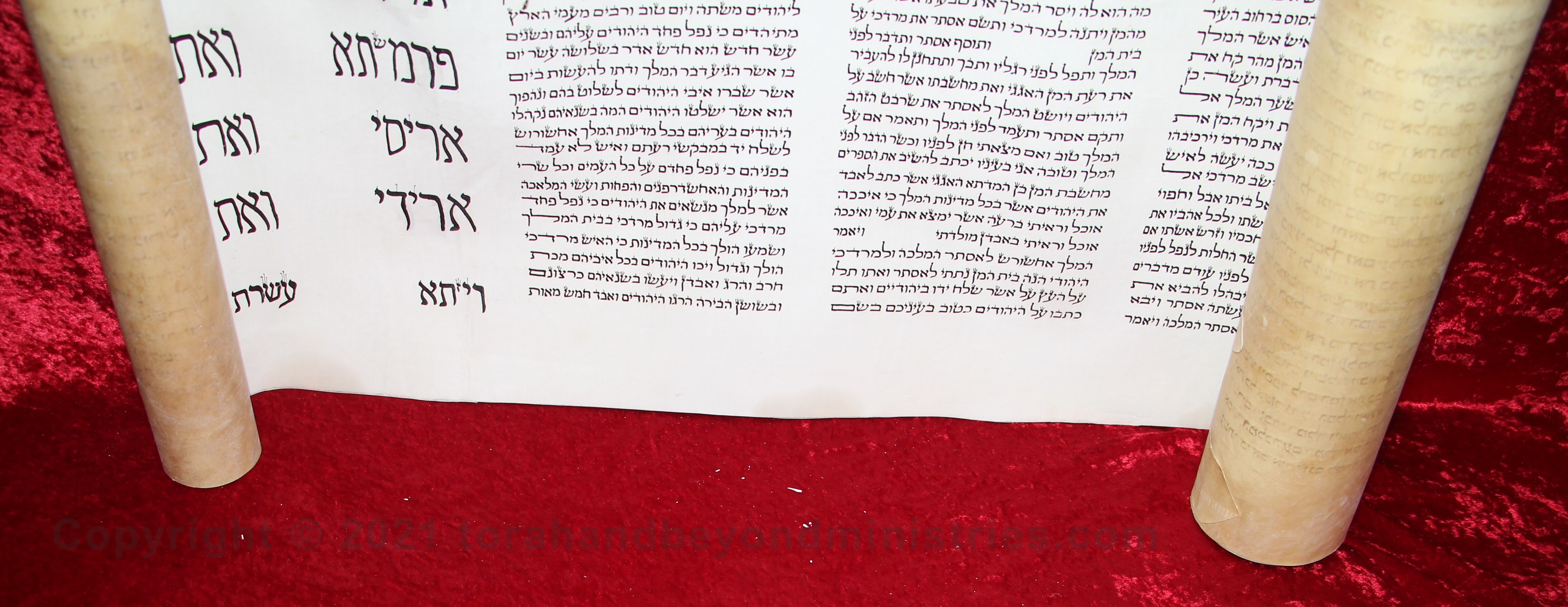
The following photograph shows the passage Esther 7:5
Then the king Ahasuerus answered and said unto Esther the queen, Who is he, and where is he, that durst presume in his heart to do so?
6 And Esther said, The adversary and enemy is this wicked Haman. Then Haman was afraid before the king and the queen.
7 And the king arising from the banquet of wine in his wrath went into the palace garden: and Haman stood up to make request for his life to Esther the queen; for he saw that there was evil determined against him by the king.
8 Then the king returned out of the palace garden into the place of the banquet of wine; and Haman was fallen upon the bed whereon Esther was. Then said the king, Will he force the queen also before me in the house? As the word went out of the king’s mouth, they covered Haman’s face.
9 And Harbonah, one of the chamberlains, said before the king, Behold also, the gallows fifty cubits high, which Haman had made for Mordecai, who had spoken good for the king, standeth in the house of Haman. Then the king said, Hang him thereon.

Compare the next photograph of a different Scroll of Esther which was written with a quill.


The Scroll of Ruth
To the best of my knowledge this Scroll of Ruth was written in Poland before 1900 and the damage was most likely caused by the movement and rough treatment of the Holocaust or subsequent Russian occupation.
The Scroll has been sewn to an acid free matting with kosher sinew purchased from Tiferes Stam Judaica in Brooklyn, New York.
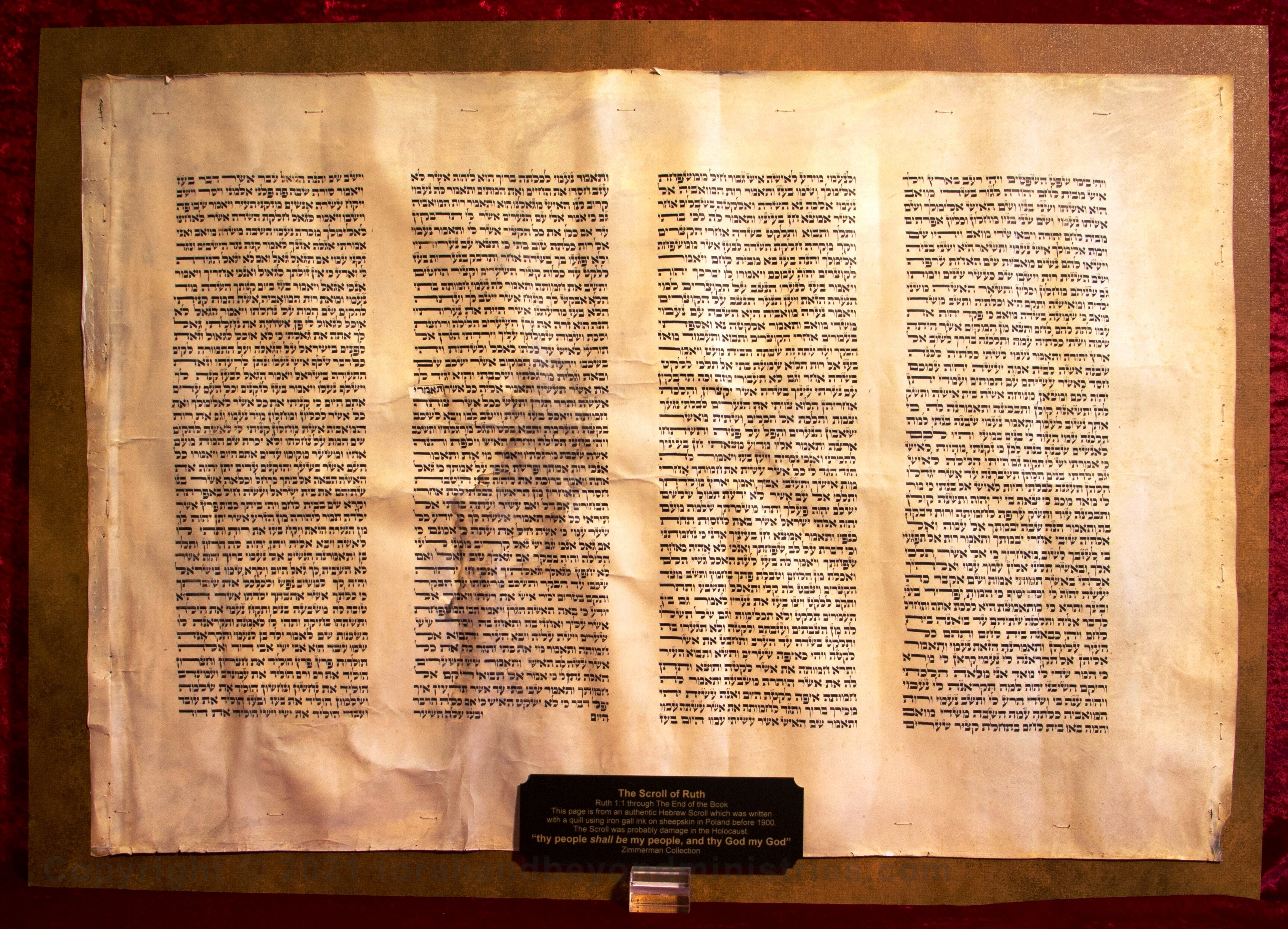



Scroll of The Song of Songs
To the best of my knowledge this Scroll of the Song of Songs was written in Poland before 1900 and the damage was most likely caused by the movement and rough treatment of the Holocaust or subsequent Russian occupation.
This Scroll is sewn to an acid mat with kosher sinew and will be framed with a shadow box effect.

“Middle Letter of the Torah”
This next sheet was framed almost 17 years ago with the pressed glass method. The sheet, which was on the market as a stand alone sheet from a damaged Scroll, was attached to an acid free mat and then pressed to the glass to hold it in place.
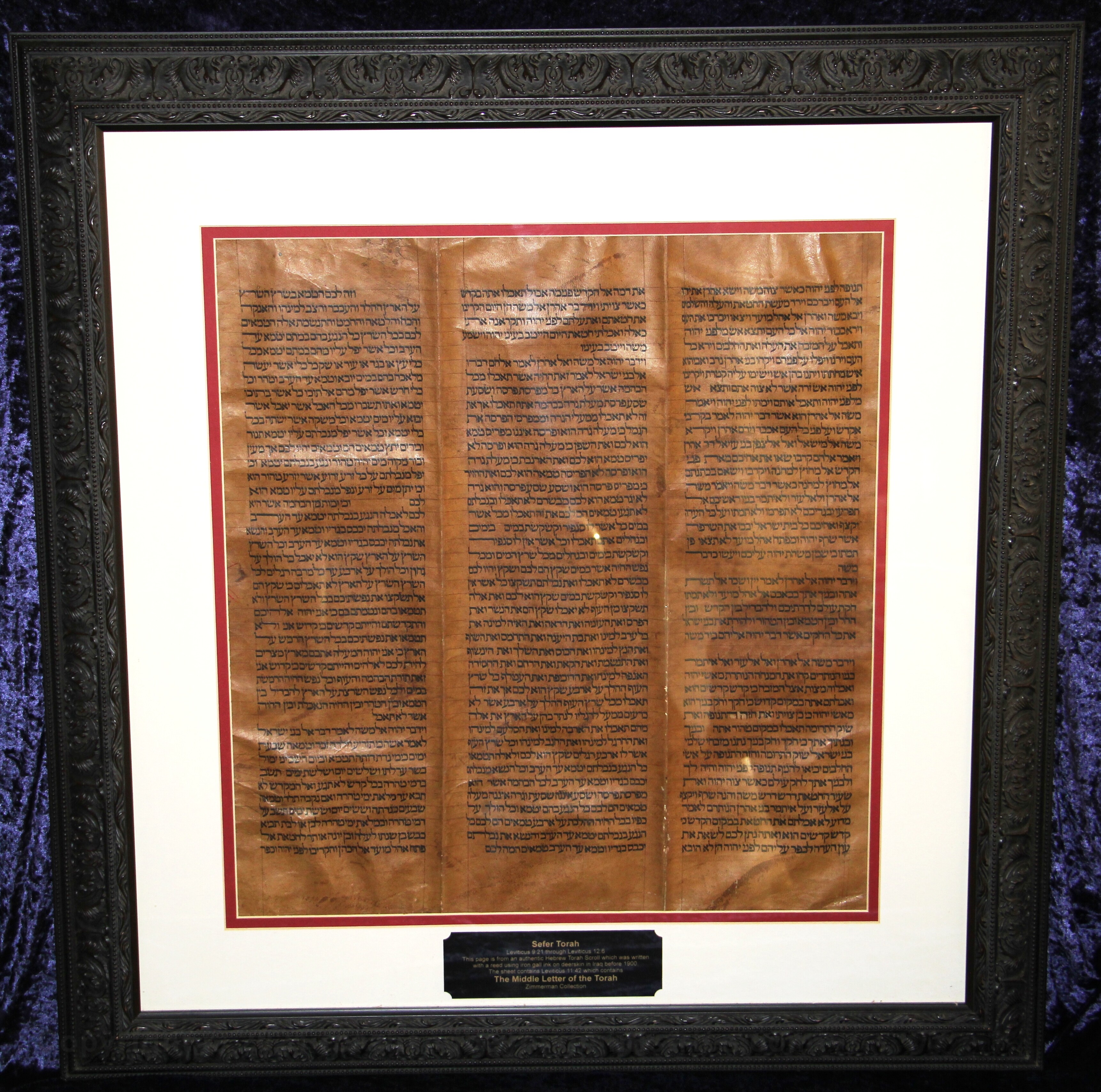
There is a saying that there is a middle letter to the Torah and that once the Torah is written the Sofer will start counting from the beginning of Genesis and 152,403 letters to the spot of Leviticus 11:42 to the third letter of the word “gahon” (belly) and the letter will be Vav –V-W. Then the sofer will start at the back of the Torah and count forward 152,403 letters and will land on the exact letter Vav –V- W in Leviticus 11:42. This is called the Middle Letter of the Torah. Now the question is; is this true?
The word Sofer is the Hebrew word for “one who counts letters”. It is true that millennia ago a person was paid to write “letters” and he was paid according to the count or number of letters written.
Upon receiving my first Sefer Torah in 1999 and all subsequent Torah scrolls since, I have checked to see if this letter is marked by making it four times the size it is supposed to be. In all Torah scrolls the letter size is increased. I have contacted several Soferim and rabbis over the years and searched Jewish literature to see what is said about the “Middle Letter of the Torah” and I have concluded that the saying is part true part rumor.
One sofer told me that they use to count letters but forgot how and do not do it any longer. He said it was not just counting the number of letters because you could misspell many words if you had a letter to take the other letter’s place. He said he thought it was counting the numerical value of the letter. There are extensive papers you can read regarding this debated subject. The Talmud in Kiddushim (30a) establishes that the accurate counting of the letters of the Torah was preserved at least until the 2nd century AD.
My conclusion is that there had to be some control indicator that made it possible to know if the Torah was exactly the same as the original. I am just not sure how they did such a good job for the last 3,500 years to have the world-wide collection of Sefri Torah in a .00004% agreement.

The following is a very good read if you are interested in this subject.
Accuracy is critical
The Jewish community is deeply concerned that the Torah says the same thing as the Scroll written by Moses. Over the millennia, they have gone to great lengths to find the answer to that question.
Rabbi Dovid Lichtman wrote an excellent article on the subject and I will summarize his work as follows. According to the authorities in Halachah, and the opinions of RamBam, Vilna Gaon, Aharon ben Moshe ben Asher, the Torah is the most honored and prized possession of the Jewish nation. It is copied with such reverence that if one letter is added or subtracted from the writing, the Torah is considered pasul and cannot be used until it is corrected. (Megilah 18b; YD #274) This creates a problem because all hand-written manuscripts are subject to errors. Humans make mistakes. At least twice Torah scholars have gone on a worldwide search throughout Jewish communities examining the pattern and accuracy of the Torahs in each region and then comparing all the regions of the world for consistency.
This is briefly the way they said the research was done. In each area, like Lithuania, Yemen, Morocco, Iraq, etc. five of the most highly revered Torah scrolls were examined as one group. Each letter was examined in the five scrolls and four of the five scrolls all had to come to 100% agreement in every single letter. Then the process was carried out in the next region. Finally, one scroll was taken from each area of the world and they were compared among themselves for consistency.
All Torah Scrolls throughout the world must be written according to code to remain consistent without error
The final conclusion according to Rabbi Dovid Lichtman is that out of the 304,805 letters in the Torah there can be found only 6 letters in discrepancy between the Masoretic text and the original Torah written by Moses. These 6 letters are discrepancies of orthography, or proper spelling of each word. They do not change the meaning of the word. The 6 letters are the letter yod y and vav w. It was concluded that the Torah we have today, if they follow the Halachah laws will be .00004% accurate.
Scrolls from Yemen were overall considered to be the most consistent as a group. The reason given was the Yemenite Jewish community was so distant from the nearest neighbor that all the scrolls followed the same Tikkun guide. It was copied from the scroll known as “Ben Asher”. This scroll was written by Aharon ben Moshe ben Asher in the 10th century. It has been accepted as the most accurate scroll in existence and has been the standard for Halakha law. I have possessed two Sefer Torahs written in Yemen in the 1700s. When examining these scrolls in comparison to the scrolls coming out of Europe, I remember saying to myself, “This sofer took no kabalistic liberties in writing this scroll”. Every letter is written exactly perfect. There were absolutely no liberties taken or embellishment of a letter. This work on accuracy of the Torah is very interesting as written by Rabbi Dovid Lichtman.

The portions of Hebrew Scrolls which have been framed are considered most holy by most Jewish people.
I have framed around 300 sheets and partial sheets from fragmented Hebrew Scrolls since 1999. Because of the large number of frames needed and I did most of the mating and mounting of the leather sheets I was able to get the large wooden frames, mats, information plates, and cut glass at a wholesale prices which came to around $60,000. A large quality museum quality frame is very expensive.

The first thing to do is make sure the manuscript will not be framed upside down.

Most people who are not familiar with Hebrew writing will turn the text upside down.

The following are a few examples.

- many Christian Bible commentaries photograph Scroills upside down
- Quite a few expensive photo books print photos of the Dead SDea Scrolls upside down
- Newspapers, TV shows, web pages show Scrolls upside down
4. Whoever frames your manuscript will probably place it in the frame upside down.
On all the framing styles use acid free mating and UV protected glass.
Because of the value and rarity of Hebrew manuscripts I always use a thick ornate wood frame.
The Hebrew manuscripts are not tanned leather; they are un-tanned parchment or velum. With the changes in temperature and humidity they sheets will expand and contract in the frames.
Thus far I have found three ways to frame a Hebrew manuscript. I will list the best and most expensive first.
There are several types of framing glass, Pick one that will reduce glare. The best and most expensive is Museum quality glass. It is about 5 times more expensive than conservation glass, but is still the best choice. Do not use acrylics which will look excellent and be lighter weight, but sooner or later someone will use Windex to clean it and it will instantly be ruined.
Identification Plate – I used brass plates for many years until I noticed the brass plates show signs of degradation, small blemishes probably caused by touching the glass. I now prefer a high quality plastic plate. When making your plate be careful to use very large lettering so people can read it from a distance.

- Sew with sinew (gid in Hebrew)

Sinew, called gid in Hebrew. This is hand spun sinew from Israel 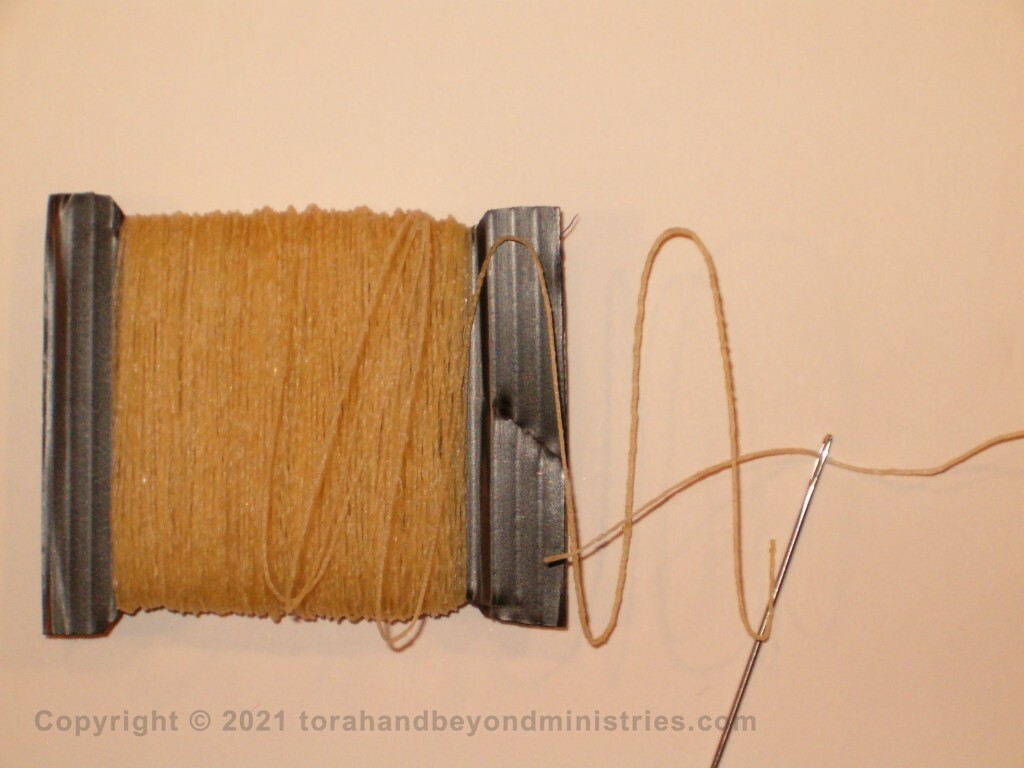
Sinew, called gid in Hebrew. This is most common in America and is machine spun. Some Sofers consider it not kosher.
The best way to mount old parchment or velum to a mat is to punch two small holes 3/16 of an inch apart about every six inches around the perimeter of the sheet. Loop sinew through both holes from the top and tie the sheet to the mat on the bottom side of the mat.
On the top mat which will face the glass cut a large hole with about two inches of the bottom mat showing around the Manuscript. Place ½ inch spacers between the top mat and the bottom mat. This will keep the Manuscript away from the glass and create a shadow box effect for the mounting.

It is very difficult to find sinew (gid in Hebrew). Do not use artificial sinew. You probably will not be able to find sinew that can be used to sew with. I keep it on hand to repair Hebrew Scrolls and frame Manuscripts. It costs me about $1.50 per foot. I will be glad to supply what you need.
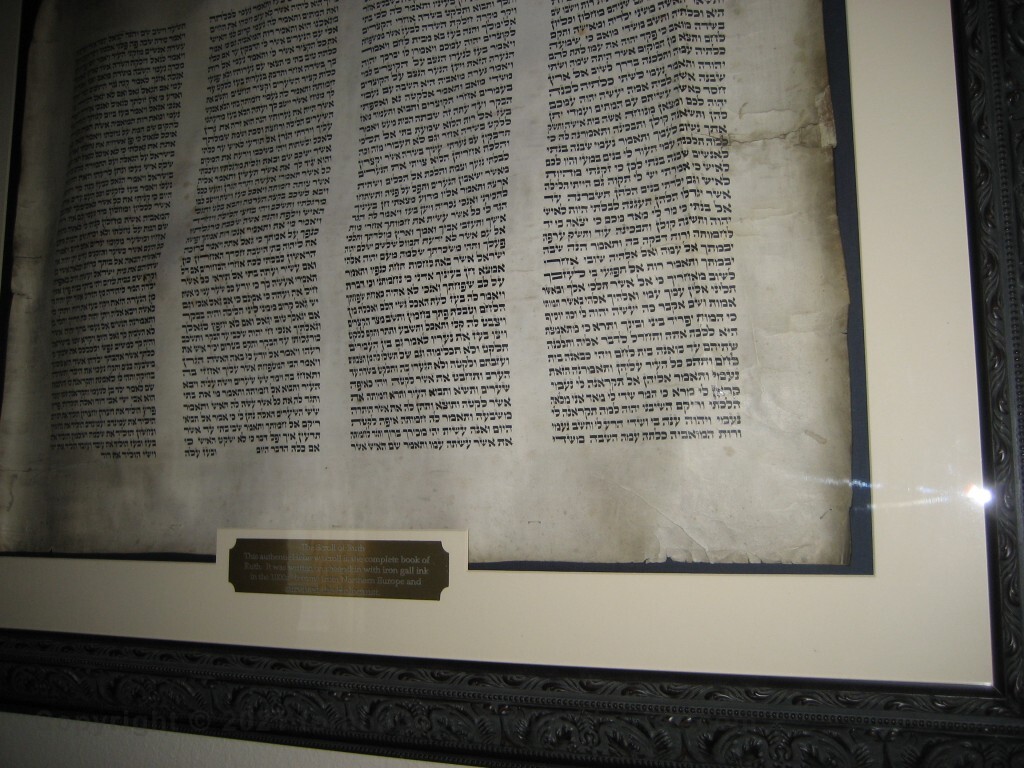
When sewing the parchment to the acid free back mat it is necessary to lay one or two pieces of heavy shelf glass on the parchment to help press out the wrinkles on the dry animal skin. It is impossible to remove the wrinkles but with the glass laying on the skin it stretches out many wrinkles. You will need to sew stitches through the skin and mat about every six to eight inches. It is only possible to pass the needle through if you first punch two holes about 3/8 inches apart with an awl like the one shown in this photograph. You must pass the sinew (gid) through the first hole from the bottom then through the next hole from the top. Tie the sinew on the bottom side. Since the sinew is very expensive, over $1 US per foot you will quickly learn the best way to tie the sinew without wasting very much. When you have sewn stitches completely around the parchment 6 to 8 inches apart you might need to sew the same way through the middle column to keep the center flat. These are tiny holes you will be punching through these priceless Hebrew Manuscripts. You can worry about if this is the best way to handle the parchments is you wish. I have framed almost 500 sheets from fragmented non kosher Scrolls and this is the most honorable way I have seen to date.
The following high resolution photographs show how I sew and display Hebrew Manuscripts.
Press the parchment to the glass
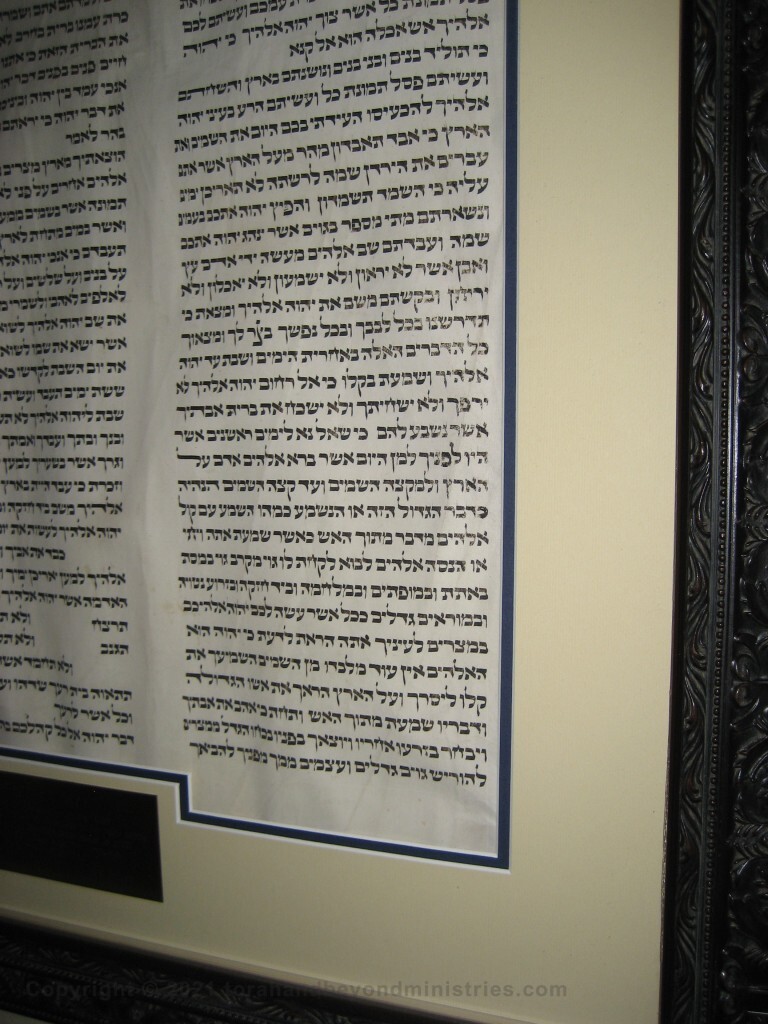
- This is the most common way to frame a large parchment, but it is difficult to do properly without a large light box. I have framed many like this, but now only use the sewing method.
Place the FRONT mat face down on a light box making sure you do not cover any of the text. Use white acid free framer’s 1 inch wide tape to affix the parchment to the mat. Place the bottom acid free mat and white corkboard on top of the parchment and place all this in a frame that has the glass installed.

- The third way is inexpensive and only works with single columns. You can get a $50 frame that has glass on both sides. Simply place the column between the glass.
Single Framing questions
Framing a single column from damaged Hebrew Scrolls. It is very easy to go to Hobby Lobby or Michael’s and find a suitable frame that already has a mass-produced printed paper to display. Simply check the size, buy the inexpensive frame, take it home and throw away the printed image and use the following designs for your Torah column. Take it to Hobby Lobby and have them cut a mat for your work.
All images om my website may be enlarged by clicking the image one or two times.



